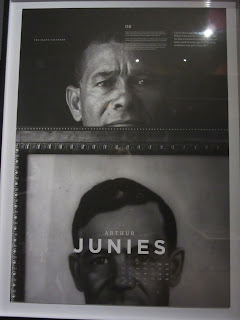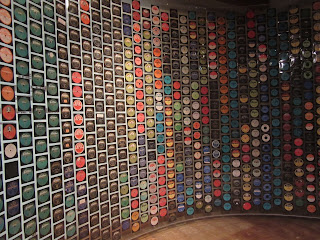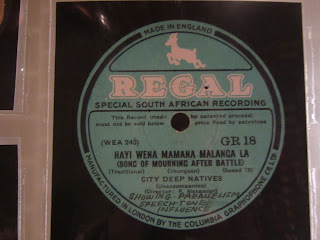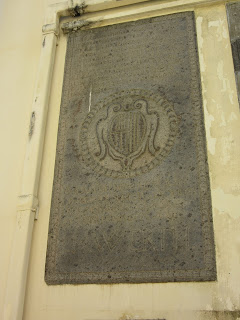Steven and I spent the earlier part of our first day in Cape Town walking around the Central Business District, especially colorful Bo-Kaap, The Company's Garden, Iziko National Gallery and St. George's Cathedral. Those places were included in my previous post but I thought our stop at Iziko Slave Lodge merited a separate post. We had read that a visit here only merited less than an hour but I knew we would likely stay longer.
The Lodge, the second oldest building in Cape Town and the country's oldest surviving slave building, was built in 1679 as the slave lodge of the Dutch East India Company. The orientation center on slavery at the Cape documented the Cape's role in the Indian Ocean slave trade route, where slaves were brought to the Cape from Indonesia, India, Ceylon, Madagascar and Mozambique.
After the abolition of the slave trade in 1807, there were two slave rebellions at the Cape, in 1808 and 1825. Though slaves living at the Cape were emancipated on December 1st, 1834, they weren't freed. Until 1838, they were apprenticed to their former owners without pay.
After the British occupation of the Cape and the 1807 abolition of the slave trade in the British Empire, the Iziko Slave Lodge became government offices and later the first Supreme Court. In the process, the Lodge was stripped of its slave history. Only in 1998, was the building renamed the Slave Lodge. The aim of the exhibit 'Remembering Slavery' was to tell of the long history of slavery in South Africa and raise awareness of human rights.
Slaves at the Cape: Slaves were introduced to the Cape in 1658, six years after the VOC (the Dutch name for the Dutch East India Company) established a refreshment station at the Cape. The Indian Ocean basin became the main region from which slaves were transported to the Cape. An infrastructure was developed at the Cape, which included a fort and a castle (The latter will be a subject in a future post.), jetties, a small town and outlying farms. The goal was to provide fresh food and water, medical assistance and repairs to the Company's boats.
Cape VOC society and its economy quickly came to depend on slavery. The long term effects of the system continue to this day.
Below is a plan of an unnamed slave ship that delivered slaves to Mauritius and Reunion, an island in the Indian Ocean, in 1826 well after the British declared an end to the slave trade in 1807. The image showed slaves packed tightly like sardines. The 200-ton ship accommodated 400 slaves.
Column of Memory: An alcove featured an interactive column of light commemorating the slaves who, as property of the VOC, were confined in the dark, damp and prison-like spaces of the Slave Lodge. The names of slaves were embedded on each ring. Turning the column and the rings symbolized a process of remembering the 8,000 names of men, women and children whose fate it was to live and die in the Slave Lodge.
The rings of the column of light were inspired by tree rings, symbolizing rings of life, the passing of time and "holding of memories." The inspiration for the column came from the story that slave auctions took place under trees in Cape Town, such as the one in the courtyard behind the Slave Lodge.
One darkened room was given over to one of the most compelling exhibits, called The Slave Calendar. We read that many of the slave-holders ended up giving slaves calendar names based on the month that they were brought to the Cape, such as February, April and September.
Many singers and bands added their voices to the struggle through their music. Jazz, rock, reggae, hip hop and other musical genres played an important role in the struggle for freedom.
The Lodge, the second oldest building in Cape Town and the country's oldest surviving slave building, was built in 1679 as the slave lodge of the Dutch East India Company. The orientation center on slavery at the Cape documented the Cape's role in the Indian Ocean slave trade route, where slaves were brought to the Cape from Indonesia, India, Ceylon, Madagascar and Mozambique.
Up to 9,000 slaves, convicts and the mentally ill are believed to have been confined in the building between 1679 and 1811. The slaves worked on public works and Dutch East India Company outposts.
Upon entering the Slave Lodge, one of the first information panels we came across described slavery as a form of domination of one person over another. As we found out when touring the Bin Jelmood House in Doha, Qatar, almost exactly one month ago on November 1st, slavery has been found in almost all cultures and continents and still persists in many forms today. Slavery existed in Africa from at least 5,000 years ago. The slave trade occurred over time down the Nile, across the Sahara Desert, over the Indian Ocean, and later, across the Atlantic Ocean.
Slaves at the Cape had no personal freedom and were the property of others. They created families but had no right to keep them. At the Cape from 1711 to 1795, slaves outnumbered colonists. While indigenous people were not enslaved, many were indentured to settlers as servants and farmhands in conditions very close to slavery.
Runaway slaves, called drosters at the Cape and maroons in the Americas, were sometimes able to create settlements on the margins of society. According to a sign, "they fought for their survival and inspired others to resist slavery."After the abolition of the slave trade in 1807, there were two slave rebellions at the Cape, in 1808 and 1825. Though slaves living at the Cape were emancipated on December 1st, 1834, they weren't freed. Until 1838, they were apprenticed to their former owners without pay.
After the British occupation of the Cape and the 1807 abolition of the slave trade in the British Empire, the Iziko Slave Lodge became government offices and later the first Supreme Court. In the process, the Lodge was stripped of its slave history. Only in 1998, was the building renamed the Slave Lodge. The aim of the exhibit 'Remembering Slavery' was to tell of the long history of slavery in South Africa and raise awareness of human rights.
Slaves at the Cape: Slaves were introduced to the Cape in 1658, six years after the VOC (the Dutch name for the Dutch East India Company) established a refreshment station at the Cape. The Indian Ocean basin became the main region from which slaves were transported to the Cape. An infrastructure was developed at the Cape, which included a fort and a castle (The latter will be a subject in a future post.), jetties, a small town and outlying farms. The goal was to provide fresh food and water, medical assistance and repairs to the Company's boats.
Cape VOC society and its economy quickly came to depend on slavery. The long term effects of the system continue to this day.
Below is a plan of an unnamed slave ship that delivered slaves to Mauritius and Reunion, an island in the Indian Ocean, in 1826 well after the British declared an end to the slave trade in 1807. The image showed slaves packed tightly like sardines. The 200-ton ship accommodated 400 slaves.
Column of Memory: An alcove featured an interactive column of light commemorating the slaves who, as property of the VOC, were confined in the dark, damp and prison-like spaces of the Slave Lodge. The names of slaves were embedded on each ring. Turning the column and the rings symbolized a process of remembering the 8,000 names of men, women and children whose fate it was to live and die in the Slave Lodge.
The rings of the column of light were inspired by tree rings, symbolizing rings of life, the passing of time and "holding of memories." The inspiration for the column came from the story that slave auctions took place under trees in Cape Town, such as the one in the courtyard behind the Slave Lodge.
West and Central Africa: Though the first two groups of slaves transported to the Cape in 1658 were from present-day Angola and Benin, very few slaves were subsequently brought from that area. Millions of slaves, taken from West Africa by European slave traders, formed the human cargoes of the transatlantic slave trade.
One of the eeriest experiences we had had in a long time was one that created a sense of what the Slave Lodge was once like. It was achieved through audio and projected images that evoked the presence of slaves by giving vivid descriptions of the trauma of everyday life inside the Lodge. The exhibit lit up in stages to take us and the other visitors into the dark and oppressive conditions of slaves' lives in the Slave Lodge. One darkened room was given over to one of the most compelling exhibits, called The Slave Calendar. We read that many of the slave-holders ended up giving slaves calendar names based on the month that they were brought to the Cape, such as February, April and September.
Below are some of the stories written by descendants of former slaves.
One man, Arthur Junies, shared the following story: "I went to work because we were seven children and I was the oldest and I had to help my mother. So I had to start working to get the other siblings to school and get them educated... I'm not concerned about what names they gave us under slavery. It was the hard way to start building South Africa. From now on we can just build on the name and be proud of where we came from and where we're going as the Junies family."
Mark September wrote that "It doesn't matter that today I'm still a slave. I think you as a human being coming from that background, should try to make things better, to try to help. Because you know exactly what the suffering was about."
Paul October related his family's story: "Just last week we had a funeral in our family. My eldest sister died. And I knew her, but I didn't know her children. I became more curious, wanting to know what more is there about our history that we don't know. What I've learned is that slaves were brought to South Africa from what is now called the Waterfront. They used to get off at the docks. Also I learned why we have the different names like October, November and those names - it was the time when our forefathers was brought to Cape Town, and they were brought in that month."
An unidentified man wrote that "Our parents never told us about our origins. In the era I grew up, older people were very secretive about their past. You were the child and I'm the parent and you don't ask any questions."
The following was most eloquently written by Nobel Peace Prize winner and Archbishop Emeritus Desmond Tutu.The story of South African slavery is one that needs to be told. They were the stonemasons, the blacksmiths, the carpenters, the people whose hands helped build this country. These are the people who had the first thing they were ever given taken from them - their names. They were stripped of the very thing that made them who they were, because they were property. Yet they lifted themselves up. You mustn't forget your roots - we tend to forget that too easily. Your roots make you who you are.
That's why the Iziko Slave Lodge Museum and The Slave Calendar project are so important. We are all a product of our history. I, Desmond Mpilo Tutu, am who I am because of this history - but it's what I make of myself: that is the difference. If you choose to lie down, then you stay down, But it's your choice to get up - and these are the stories of those who have. These are the stories of hope."
Along with its permanent exhibits, the Slave Lodge hosts travelling exhibitions that raise current civil and human rights issues around the world and pay tribute to those 'who have been forgotten, denied and stigmatized'. One of those was called Singing Freedom: Music and the Struggle against Apartheid. For the oppressed in South Africa, freedom songs were a weapon in the struggle against colonial conquest and apartheid.
For most people in South Africa, freedom songs are part of the collective memory of the struggle against apartheid. The songs told the story of the people, organizations, events, ideologies, beliefs, hopes, dreams and emotions that were part of the struggle for freedom.Many singers and bands added their voices to the struggle through their music. Jazz, rock, reggae, hip hop and other musical genres played an important role in the struggle for freedom.
Many organizations were formed during the struggle against apartheid. Each of these had their particular freedom songs. There were, however, a number of freedom songs common to many different organizations. In addition, there were songs adopted from international struggles. One example of such a song was The Red Flag which was frequently sung within the South African Communist Party and trade unions.
Steve Biko was an anti-apartheid activist in South Africa in the 1960s and 1970s until his death while in police custody in 1977 at the age of just 30. As a student leader, Biko found the Black Consciousness Movement which mobilized much of South Africa's urban black population. Biko wrote that "Any suffering we experienced was made more real by song and rhythm which leads to a culture of defiance, self-assertion and group pride and solidarity."
Labels was the name of a temporary exhibition in The Slave Lodge that carried on the earlier musical theme. It was an installation of over 2,500 digital prints of scanned record labels belonging to a South African artist, Siemon Allen, living and working in the US.
According to the artist, "The work functions as a historical record, a chronological discography of select labels from the entire archive of South African audio."
I am sure you are all familiar with the music of Harry Belafonte but probably, like me, had never heard of Makeba, one of his frequent singing partners. Zenzile Miriam Makeba, nicknamed Mama Africa, was a South African singer and civil rights activist. In the 1960s, she was the first artist from Africa to popularize African music around the world. She is best known for the song Pata Pata, first recorded in 1957 and released in the U.S. in 1967. In addition to recording and touring with Harry Belafonte, she also recorded with Paul Simon and many other popular artists.
Makeba campaigned against the South African system of apartheid. The South African government responded by revoking her passport in 1960 and her citizenship and right of return in 1963. As the apartheid system fell apart, she returned home for the first time in 1990.
Makeba campaigned against the South African system of apartheid. The South African government responded by revoking her passport in 1960 and her citizenship and right of return in 1963. As the apartheid system fell apart, she returned home for the first time in 1990.
Seeing this Soweto label reminded me that we had first seen the image of Miriam Makeba on the outside of the huge Orlando Towers when we toured Soweto on November 22nd. That photo is part of my post from that date.
Kynoch Ammunition Display Case: Kynoch Limited was founded by George Kynoch, an English ammunition maker and Member of Parliament. In 1888, he left the firm and became a gun dealer and established branch offices in several South African towns. He died in 1891 in South Africa.
When we travel to new countries, I am always intrigued at finding out the meaning of, or information about, each country's flag. At the Slave Lodge, I read that the green, central design of South Africa's flag, which was adopted in 1984, was unique. The wide part of the 'V' begins at the flagpole before extending further, as a single horizontal band to the flag's outer edge. This was apparently 'symbolic of the different groups of people in South African society, coming together, and taking the road ahead together.'
The following are photos from the Lodge's courtyard. Even though it appeared to be very peaceful and serene, we knew it had been the scene of much heartache for so many years.
Visiting The Slave Lodge reminded me of how very easy it is to ignore the plight of others as we go about our everyday lives. However, our time there emphasized the horror of life as a slave in the Cape. We wondered how it was, and sadly still is, truly possible to treat our fellow man in such a horrific manner.
Posted from Littleton, Colorado on January 31st, 2017.
Posted from Littleton, Colorado on January 31st, 2017.









































Great and informative post as usual. I wish we'd visited Cape Town. This would have been emotional for me. I love Makebas's music and remember the joy when she was finally back home after apartheid :-).
ReplyDelete